Related Research Articles

A molecular cloud, sometimes called a stellar nursery (if star formation is occurring within), is a type of interstellar cloud, the density and size of which permit absorption nebulae, the formation of molecules (most commonly molecular hydrogen, H2), and the formation of H II regions. This is in contrast to other areas of the interstellar medium that contain predominantly ionized gas.

A nebula is a distinct luminescent part of interstellar medium, which can consist of ionized, neutral or molecular hydrogen and also cosmic dust. Nebulae are often star-forming regions, such as in the "Pillars of Creation" in the Eagle Nebula. In these regions, the formations of gas, dust, and other materials "clump" together to form denser regions, which attract further matter, and eventually will become dense enough to form stars. The remaining material is then thought to form planets and other planetary system objects.

A dark nebula or absorption nebula is a type of interstellar cloud, particularly molecular clouds, that is so dense that it obscures the visible wavelengths of light from objects behind it, such as background stars and emission or reflection nebulae. The extinction of the light is caused by interstellar dust grains located in the coldest, densest parts of molecular clouds. Clusters and large complexes of dark nebulae are associated with Giant Molecular Clouds. Isolated small dark nebulae are called Bok globules. Like other interstellar dust or material, things it obscures are only visible using radio waves in radio astronomy or infrared in infrared astronomy.

The Orion Nebula is a diffuse nebula situated in the Milky Way, being south of Orion's Belt in the constellation of Orion, and is known as the middle "star" in the "sword" of Orion. It is one of the brightest nebulae and is visible to the naked eye in the night sky with apparent magnitude 4.0. It is 1,344 ± 20 light-years (412.1 ± 6.1 pc) away and is the closest region of massive star formation to Earth. The M42 nebula is estimated to be 24 light-years across. It has a mass of about 2,000 times that of the Sun. Older texts frequently refer to the Orion Nebula as the Great Nebula in Orion or the Great Orion Nebula.
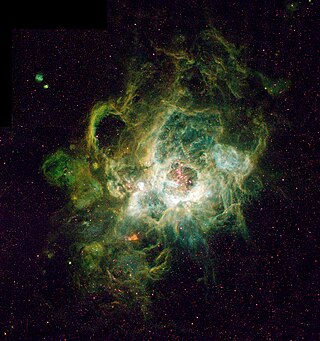
An H II region or HII region is a region of interstellar atomic hydrogen that is ionized. It is typically in a molecular cloud of partially ionized gas in which star formation has recently taken place, with a size ranging from one to hundreds of light years, and density from a few to about a million particles per cubic centimetre. The Orion Nebula, now known to be an H II region, was observed in 1610 by Nicolas-Claude Fabri de Peiresc by telescope, the first such object discovered.

The Horsehead Nebula is a small dark nebula in the constellation Orion. The nebula is located just to the south of Alnitak, the easternmost star of Orion's Belt, and is part of the much larger Orion molecular cloud complex. It appears within the southern region of the dense dust cloud known as Lynds 1630, along the edge of the much larger, active star-forming H II region called IC 434.

NGC 281, IC 11 or Sh2-184 is a bright emission nebula and part of an H II region in the northern constellation of Cassiopeia and is part of the Milky Way's Perseus Spiral Arm. This 20×30 arcmin sized nebulosity is also associated with open cluster IC 1590, several Bok globules and the multiple star, B 1. It collectively forms Sh2-184, spanning over a larger area of 40 arcmin. A recent distance from radio parallaxes of water masers at 22 GHz made during 2014 is estimated it lies 2.82±0.20 kpc. from us. Colloquially, NGC 281 is also known as the Pacman Nebula for its resemblance to the video game character.

Barnard's Loop is an emission nebula in the constellation of Orion. It is part of the Orion molecular cloud complex which also contains the dark Horsehead and bright Orion nebulae. The loop takes the form of a large arc centered approximately on the Orion Nebula. The stars within the Orion Nebula are believed to be responsible for ionizing the loop.

The Orion molecular cloud complex is a star-forming region with stellar ages ranging up to 12 Myr. Two giant molecular clouds are a part of it, Orion A and Orion B. The stars currently forming within the complex are located within these clouds. A number of other somewhat older stars no longer associated with the molecular gas are also part of the complex, most notably the Orion's Belt, as well as the dispersed population north of it. Near the head of Orion there is also a population of young stars that is centered on Meissa. The complex is between 1 000 and 1 400 light-years away, and hundreds of light-years across.

The Flame Nebula, designated as NGC 2024 and Sh2-277, is an emission nebula in the constellation Orion. It is about 900 to 1,500 light-years away.
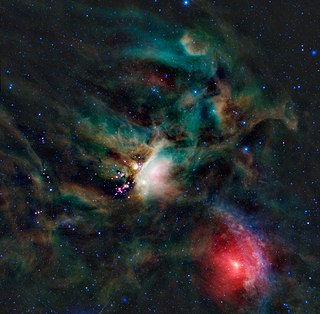
The Gould Belt is a local ring of stars in the Milky Way, tilted away from the galactic plane by about 16–20 degrees, first reported by John Herschel and Benjamin Gould in the 19th century. It contains many O- and B-type stars, and many of the nearest star-forming regions of the local Orion Arm, to which the Sun belongs. The relative proximity of these star-forming regions spurred the Gould Belt Survey project to determine what caused them.
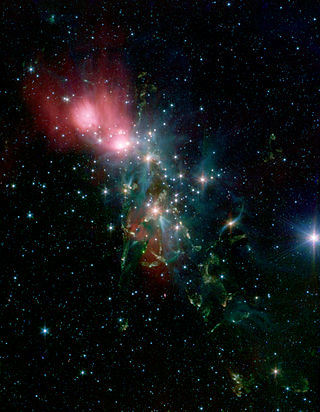
NGC 1333 is a reflection nebula located in the northern constellation Perseus, positioned next to the southern constellation border with Taurus and Aries. It was first discovered by German astronomer Eduard Schönfeld in 1855. The nebula is visible as a hazy patch in a small telescope, while a larger aperture will show a pair of dark nebulae designated Barnard 1 and Barnard 2. It is associated with a dark cloud L1450. Estimates of the distance to this nebula range from 980–1,140 ly (300–350 pc).

IC 5146 is a reflection/emission nebula and Caldwell object in the constellation Cygnus. The NGC description refers to IC 5146 as a cluster of 9.5 mag stars involved in a bright and dark nebula. The cluster is also known as Collinder 470. It shines at magnitude +10.0/+9.3/+7.2. Its celestial coordinates are RA 21h 53.5m, dec +47° 16′. It is located near the naked-eye star Pi Cygni, the open cluster NGC 7209 in Lacerta, and the bright open cluster M39. The cluster is about 4,000 ly away, and the central star that lights it formed about 100,000 years ago; the nebula is about 12 arcmins across, which is equivalent to a span of 15 light years.

Barnard 68 is a molecular cloud, dark absorption nebula or Bok globule, towards the southern constellation Ophiuchus and well within the Milky Way galaxy at a distance of about 125 parsecs. It is both close and dense enough that stars behind it cannot be seen from Earth. American astronomer Edward Emerson Barnard added this nebula to his catalog of dark nebulae in 1919. His catalog was published in 1927, at which stage it included some 350 objects. Because of its opacity, its interior is extremely cold, its temperature being about 16 K (−257 °C/-431 °F). Its mass is about twice that of the Sun and it measures about half a light-year across.

The Rho Ophiuchi cloud complex is a complex of interstellar clouds with different nebulae, particularly dark nebulae which is centered 1° south of the star ρ Ophiuchi, which it among others extends to, of the constellation Ophiuchus. At an estimated distance of 131 ± 3 parsecs, or 460 light years, it is one of the closest star-forming regions to the Solar System.
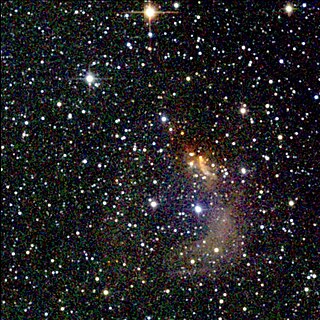
Vela Molecular Ridge is a molecular cloud complex in the constellations Vela and Puppis. Radio 12CO observations of the region showed the ridge to be composed of several clouds, each with masses 100,000–1,000,000 M☉. This cloud complex lies on the sky in the direction of the Gum Nebula (foreground) and the Carina–Sagittarius Spiral Arm (background). The most important clouds in the region are identified by the letters A, B, C and D, and in fact belong to two different complexes: the clouds A, C and D are located at an average distance of about 700-1000 parsecs and are related to the OB association Vela R2, while cloud B is located at a greater distance, up to 2000 parsecs away, and is physically connected to the extended Vela OB1 association.
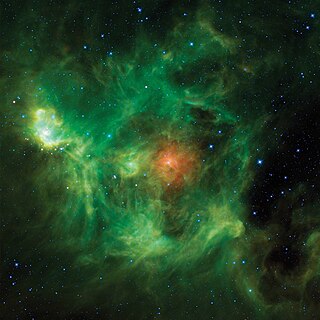
The Wreath Nebula (also known as Barnard 3 or IRAS Ring G159.6-18.5 is an emission nebula and H II region with a radius of about 22 light-years, located about 1,000 light-years away within the Milky Way in the Perseus molecular cloud complex, near the boundary with the constellation of Taurus. Interstellar clouds like these are stellar nurseries, places where new stars are being born.

The Radcliffe wave is the nearest coherent gaseous structure in the Milky Way, dotted with a related high concentration of interconnected stellar nurseries. It stretches about 8,800 light years. It runs with the trajectory of the Milky Way arms, and lies at its closest at around 400 light-years and at its farthest about 5,000 light-years from the Sun, always within the Local Arm itself, spanning about 40% of its length and on average 20% of its width. Its discovery was announced in January 2020 and its proximity surprised astronomers.
References
- ↑ Hubl, Bernhard (2018-02-24). "Bernhard Hubl - B 1". www.astrophoton.com. Retrieved 2023-03-26.
- ↑ Hubl, Bernhard (2008-08-01). "Bernhard Hubl Astrophotography". www.astrophoton.com. Retrieved 2023-03-26.
- ↑ Ford, Dominic. "Barnard 1 (Dark nebula)". In-The-Sky.org. Retrieved 2023-03-26.